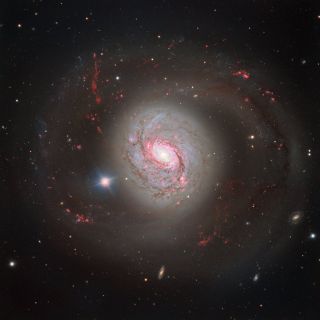'Spectacular' Spiral Galaxy Shines in View from Very Large Telescope (Photo, Video)
The European Southern Observatory's (ESO) Very Large Telescope (VLT) has captured a stunning image of a spiral galaxy called Messier 77.
Messier 77 is about 100,000 light-years across — so massive that it actually warps nearby galaxies, ESO officials said in a statement. It's an active galaxy — one of the "most energetic and spectacular objects in the universe," according to the ESO. And while the photo effectively portrays the galaxy's beauty, according to the ESO, it fails to depict the sheer power of an active galaxy like Messier 77.
An accretion disk — the buildup of gas, dust and other material — surrounding a supermassive black hole in the galaxy shoots "intense radiation" out into the galaxy, causing Messier 77 to be one of the brightest objects in the universe, ESO officials said. Nuclei of active galaxies are often brighter than the rest of the galaxy, and they emit light at nearly all wavelengths, including gamma-rays, X-rays, microwaves and radio waves.

In addition to being an active galaxy, Messier 77 is also classified as a type 2 Seyfert galaxy, which means it's especially bright when viewed at infrared wavelengths.
Four different wavelengths that Messier 77 emits are visible in the image captured by the ESO, represented in blue, red, violet and pink. The pink spots show hotter, younger stars forming in the galaxy's spiral arms, according to the ESO statement, and the red spots are filament-like structures in the gas surrounding the galaxy.
Distant galaxies are also visible in this image, at the outer edges of Messier 77's spiral arms, as is a foreground star in the Milky Way, which can been seen near the galaxy's center.
Editor's Note: Space.com senior producer Steve Spaleta contributed to this report.
Get the Space.com Newsletter
Breaking space news, the latest updates on rocket launches, skywatching events and more!
Follow Kasandra Brabaw on Twitter @KassieBrabaw. Follow us @Spacedotcom, Facebook and Google+. Original article on Space.com.
Join our Space Forums to keep talking space on the latest missions, night sky and more! And if you have a news tip, correction or comment, let us know at: community@space.com.

Kasandra Brabaw is a freelance science writer who covers space, health, and psychology. She's been writing for Space.com since 2014, covering NASA events, sci-fi entertainment, and space news. In addition to Space.com, Kasandra has written for Prevention, Women's Health, SELF, and other health publications. She has also worked with academics to edit books written for popular audiences.
